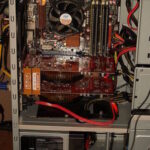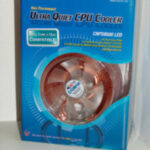Unlike many people who are buying computers these days, I was fortunate enough to grow up with computers around the house, and working on then and playing with them growing up. I know many people have no idea what they are looking at when they go looking for a computer, and end up buying something they are talked into or have no need for. I hope to be able to explain and break down the parts of a computer so you can become a better educated consumer.
The first part is the CPU. CPU stands for Central Processing Unit. In basic terms this is the brain, it does the math required to figure things out. First thing I will talk about is the speed. It will be described in gHz, for example 2.4gHz processor. This is a rated speed at which it can process data. The higher, usually the better, but not always. There are two major CPU manufacturer’s, Intel and AMD. Both have pro’s and con’s, Intel has better power for the rated speed, but cost’s more, the AMD I would consider a budget option, but what I used because its the best bang for the buck. Now onto the number of core’s a CPU has. Think of this like being able to multi-task. If you can’t do two things at once, you only have a single core, if you can do two things at the same time without slowing down, you have dual core… Computers have up to 4 cores at this time, but the future is endless. The quad (4) core CPU’s are top of the line right now, but also very expensive.
The next part is the RAM. RAM stands for Random Access Memory. I will describe this as short term memory, for example if you are doing a math problem, you might need to remember a variable while you work on the problem, but once the problem is solved you no longer need this information. This is what RAM does on your computer, it holds temporary information required to make the calculations the CPU is working on, but not required in the final product. As with the CPU the bigger the number usually the better. There are different rated speeds of ram, and different set-ups. First of there are DDR, DDR2 and DDR3, these are different formats, and allow for more speed. Of course DDR3 is top of the line for RAM, but you have to be running a top of the line system to be capable of using, and it costs a little more, where DDR2 that is rated at a similar speed it will not be a noticeable difference. The speed the RAM is rated in numbers such as 533, 800, 1333, 1600 and more. Again, the higher the better, but the higher the more expensive, and your computer has to be able to accept it. Most computers running any Operating System (the program that boots up such as Windows Vista) will operate on 2 gigs of ram, I personally suggest a minimum of 2 gigs of ram. If you want to run more, make sure your system is going to be operating with an Operating system that is rated at 64-bit instead of 32-bit. To get full access of more than 3.5 gigs of ram, you have to be running an Operating System rated at 64-bit or you don’t get everything out of the RAM.
The next part I will Talk about is the Optical Drive. This is your disc drive. Be it a CD player, CD burner, DVD player, DVD burner, blu-ray player, or blu-ray burner. The DVD burner is almost standard on any computer sold today, there are a few brands out there, but for the most part, I would make sure you have a DVD burner, it comes in handy to back up data, including home videos pictures or music. If you want to splurge and put a Blu-Ray on it there are some decent models out there, but you just have to be aware you are making an investment, and you have to make sure your graphics card is capable of HDCP (High Definition Content Protection) or you will not be able to view Blu-Ray movies on your computer. Most modern graphics cards are developed with HDCP, as well as many built in graphics cards on motherboards for systems without a dedicated graphics card.
I will now talk about the graphics card. Many systems have built in graphics cards, some with built in HDMI outputs so you can plug your computer straight into your HD TV. These will do great things for people who just surf the Internet, watch movies and video’s on their computer. People are interested in hard core, graphically intense games, need to look into Video Cards. Now with these you just have to realize there is a never ending battle between Graphics card manufactures Nvidia and ATI. The latest dedicated graphics cards cost in upwards of $500 alone, but for the average gamer a good $150 card will do the job. At this point I would say almost any card in the $130-180 price range would make a good graphics card for someone that enjoys gaming but doesn’t need the top of the line product.
I will no talk about the Mother Board. This is what determines what you can have in your computer. Now if you are buying a prebuilt computer, this is not important to you, unless you hope to upgrade your system. The mother board determines the type’s of CPU’s you can use, the type and amount of RAM you can use, and the kind of Graphics card or amount of Graphics cards you can use. Overall if you are new to computers and have no plans on tinkering on the inside of the case.. or ever even look inside the case, I wouldn’t worry much about the motherboard they use to make your computer, they are going to pick the best one for the rest of the components that are being put into the computer.
Finally I will talk about storage. There are few different types of storage. First off is HDD, the Hard Drive Disc. Which is what is considered the traditional storage media for computers for many years. They come in sizes as small as 80 gigs, up to 1.5 terabytes (1500gigs). They also come in different speeds 5400 rpm, 7200 rpm are the standards. 5400 is standard for use on laptops and 7200 is used for desktops. This number just states how fast the disc spins to be able to access the information written on them. I personally suggest a smaller HDD (under 320 gigs) for you programs, your Operating System, games, and other programs you run on your computer. Then a second drive for the storage of Media, Video’s, Picture’s, and Music. There is also SSD, Solid State Drive. This is a form of flash memory. It has no moving parts, so it access the information almost instantly, making it fast and ideal for speed and stability as well as weight saving properties, but the cost is extremely high in comparison to that of HDD. SSD range in size from 8 gigs to 128 gigs, so the storage options are limited as well.
I hope this information has helped educate you and help you in the computer shopping and buying process.




